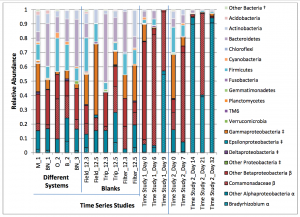This is one of those stories / articles / posts that simultaneously fascinates me and freaks me out a bit and for which I fluctuate wildly between those two points of view: bioME – RSA Human By Nature Entry on Behance By Candice de Aguiar Her basic design idea here is to allow for more microbial diversity …
There is an interesting and potentially important new paper out from Caitlin Proctor, Marc Edwards and Amy Pruden: Microbial composition of purified waters and implications for regrowth control in municipal water systems in Environmental Science: Water Research & Technology. The abstract is below:
What’s that cool structure in that UC Davis research field? It’s an egg mobile! Egg mobiles are exactly what they sound like — a mobile chicken coop that can be towed to a different location, such as a different area of a pasture. There are nestboxes and roosts inside for the egg-laying chickens; they also have …
A presentation at the 2015 International Conference on Emerging and Infectious Diseases held August 24 – 26 in Atlanta, Georgia is getting a bit of attention and may be of interest (though I could not find any data yet behind it). Basically a group from UNSW looked at transmission of RSCV in a NICU and as part …
An article at Space.Com discusses a new push to make sure that spacecraft do not inadvertently contaminate the places they are visiting (e.g., Mars). What microbes are on space vehicles and how to make sure the parts that are sent to other planets are “clean” or “sterile” is an interesting and active area of research. …
Scientists are announcing the discovery of thousands of unidentified species living in and around homes in the United States. NC State has a press release / mini story about the recent paper from the Wildlife of Your Homes project — Source: Citizen Science Effort Highlights How Little We Know About Invisible Life in Our Own …
In dust one can record the actions of storms, the wearing of mountains, the consequences of industrialization. The study of dust has a long history. Geologists consider it. Toxicologists too. Arthur Conan Doyle has Sherlock Holmes look to dust to discern where a criminal might have traveled. But perhaps the most telling feature of dust …
There is a story in BBC News on the new paper from the Wildlife of Your Homes Project. By Rebecca Morelle. The dust in our homes contains an average of 9,000 different types of fungi and bacteria, a study suggests. Source: Thousands of microbes found in house dust – BBC News
Dust gathering in homes at this very moment is more alive than you might think. There is a story by Jennifer Viegas in Discovery News about a new paper from Noah Fierer, Rob Dunn and others on the microbiology of household dust. Source: Bacteria in Household Dust Reflect Who Lives There : Discovery News
. Sarah Zhang at Wired has updated her post from three years ago about bacteria in her apratment with reference to a new study just published from the Wildlife of Your Homes study of bacteria and fungi in homes. Definitely worth a look. Source: What I Learned From Sequencing the Bacteria in My Apartment | …





